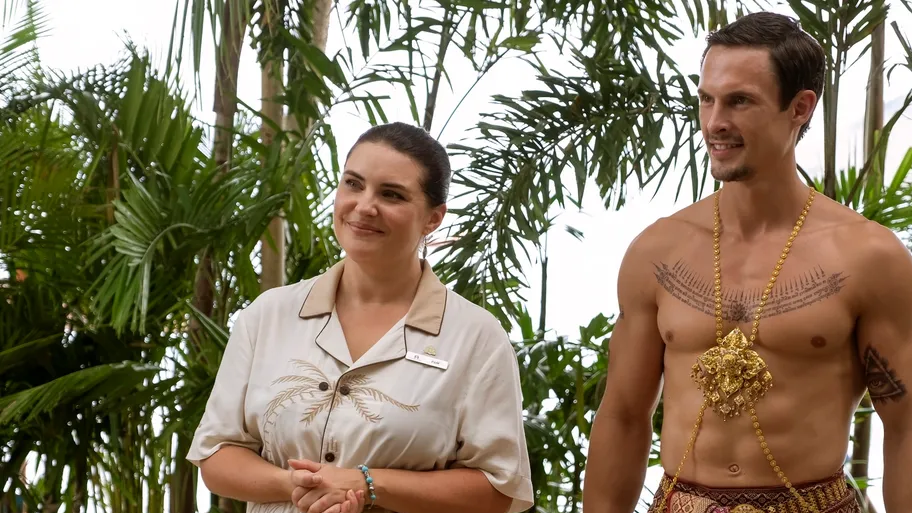Well, well, well—we’ve checked into The White Lotus season 3 and found ourselves at a full-blown wellness resort. The previous two properties on Maui and Sicily had spas, sure, but this Thailand outpost takes it to another level with health mentors, personalized regimens, and digital detox bags for cellphones. Fear not, for much else remains the same—such as the deluge of drinking, the painful interactions between staff and guests, and the uber-luxurious lodgings that override viewers’ critical consideration of the show’s morally ambiguous characters (played this time around by the likes of Parker Posey, Walton Goggins, and Carrie Coon) and leave them saying, “I want to go to there.” Somebody, again, is dead. Although the body floating in the shallows of the spa resort’s pond in the opening scene suggests they didn’t asphyxiate in a malfunctioning sensory deprivation tank.
After parsing all the questions that the premiere raises (Top of mind: Is the fruit of the poisonous pong pong tree the real killer, and the gunshots a mere red herring?) we’ve decided to take a beat to unpack all the wellness buzzwords that feature in episode one.
The Ratliff progeny look on in disbelief as Pam informs them of their villa’s lack of wifi.
Fabio Lovino/HBO
Digital detox
When Lochlan Ratliff (Sam Nivola), the youngest member of the wealthy North Carolina Ratliff clan, asks health mentor Pam (Morgana O’Reilly) for the wifi password, she responds, “The hotel is a digital detox area—focus on being present, and each other, and self-care,” before adding in response to near-unanimous upset, “It’s optional.” Indeed, signs marking cellphones with a circle and an X are often pointed to when a guest (not infrequently) takes a call or text in the dining room, but not once does a staff member swoop in to correct the behavior. This is in keeping with the largely lax real-life digital detox policies at comparable properties, where guests opt-in and out of the no phones policy at will. Condé Nast Traveler‘s senior features editor Rebecca Misner says, “It seems less of a formalized offering. I’ve seen no phone zones at resort pools. Of course, most spas ask you don’t have your phone with you.” One such case? The signal-blocking phone bag offered to writer Kelsey Eisen during her Burnout Recovery Journey at Sanctuary Beach Resort in Monterey Bay, California. Traveler contributor Maria Yagoda, meanwhile, can only recall one-time that she felt like the no phone policy was actually mandatory, and that was at Iceland’s The Retreat at Blue Lagoon: “That’s the only place I actually left my phone in the spa locker because I was scared I was going to get in trouble—which is agonizing because it’s so beautiful [there]. They have a system where you can ask the staff to take a photo of you on their phones and they’ll send it to you later. Which also sucks because as we all know, random strangers take the worst photos of us and almost never get the shot.”
Personalized wellness regimens
Immediately after the detox exchange, Pam segues into her spiel about how the Ratliffs won’t even have time to be bored on account of the busy schedule they’ll have “based on [their] own personal goals” and a biometrics test. Posey’s Victoria Raitliff replies, “I don’t want to take a test. Is it complicated? We’re jet-lagged…” to which Pam responds, “We get a whole bunch of data, and I take those results and create a personal plan that best suits your needs.” At this point, it would be accurate to describe personalized regimens, established through biometric testing (the quick measurement of such quantities as weight and blood pressure, with various levels of high-tech dress-up) as ubiquitous at luxury spa resorts. I don’t say this simply because, during my stay at The Ranch Hudson Valley, I sat inside an egg-shaped pod that shot highly-pressurized air at my speedo-clad body to assess my body fat percentage. When asked, Misner rattles off a laundry list of properties doing something similar in this vein: “1 Hotel Hanalei Bay has a whole medi arm, Sensei, SHA, Zulal Wellness Resort by Chiva Som, Canyon Ranch, various Four Seasons, and then quite a few medi spas in Europe like Lanserhof and Chenot.”

